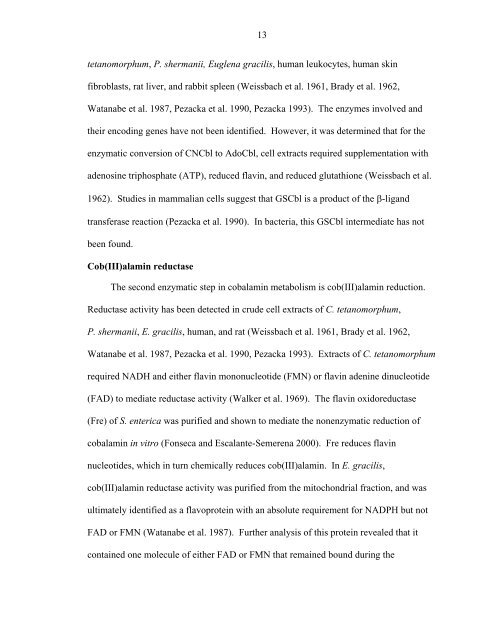B12 METABOLISM IN HUMANS By NICOLE AURORA LEAL A ...
B12 METABOLISM IN HUMANS By NICOLE AURORA LEAL A ...
B12 METABOLISM IN HUMANS By NICOLE AURORA LEAL A ...
Create successful ePaper yourself
Turn your PDF publications into a flip-book with our unique Google optimized e-Paper software.
tetanomorphum, P. shermanii, Euglena gracilis, human leukocytes, human skin<br />
fibroblasts, rat liver, and rabbit spleen (Weissbach et al. 1961, Brady et al. 1962,<br />
Watanabe et al. 1987, Pezacka et al. 1990, Pezacka 1993). The enzymes involved and<br />
13<br />
their encoding genes have not been identified. However, it was determined that for the<br />
enzymatic conversion of CNCbl to AdoCbl, cell extracts required supplementation with<br />
adenosine triphosphate (ATP), reduced flavin, and reduced glutathione (Weissbach et al.<br />
1962). Studies in mammalian cells suggest that GSCbl is a product of the β-ligand<br />
transferase reaction (Pezacka et al. 1990). In bacteria, this GSCbl intermediate has not<br />
been found.<br />
Cob(III)alamin reductase<br />
The second enzymatic step in cobalamin metabolism is cob(III)alamin reduction.<br />
Reductase activity has been detected in crude cell extracts of C. tetanomorphum,<br />
P. shermanii, E. gracilis, human, and rat (Weissbach et al. 1961, Brady et al. 1962,<br />
Watanabe et al. 1987, Pezacka et al. 1990, Pezacka 1993). Extracts of C. tetanomorphum<br />
required NADH and either flavin mononucleotide (FMN) or flavin adenine dinucleotide<br />
(FAD) to mediate reductase activity (Walker et al. 1969). The flavin oxidoreductase<br />
(Fre) of S. enterica was purified and shown to mediate the nonenzymatic reduction of<br />
cobalamin in vitro (Fonseca and Escalante-Semerena 2000). Fre reduces flavin<br />
nucleotides, which in turn chemically reduces cob(III)alamin. In E. gracilis,<br />
cob(III)alamin reductase activity was purified from the mitochondrial fraction, and was<br />
ultimately identified as a flavoprotein with an absolute requirement for NADPH but not<br />
FAD or FMN (Watanabe et al. 1987). Further analysis of this protein revealed that it<br />
contained one molecule of either FAD or FMN that remained bound during the

















